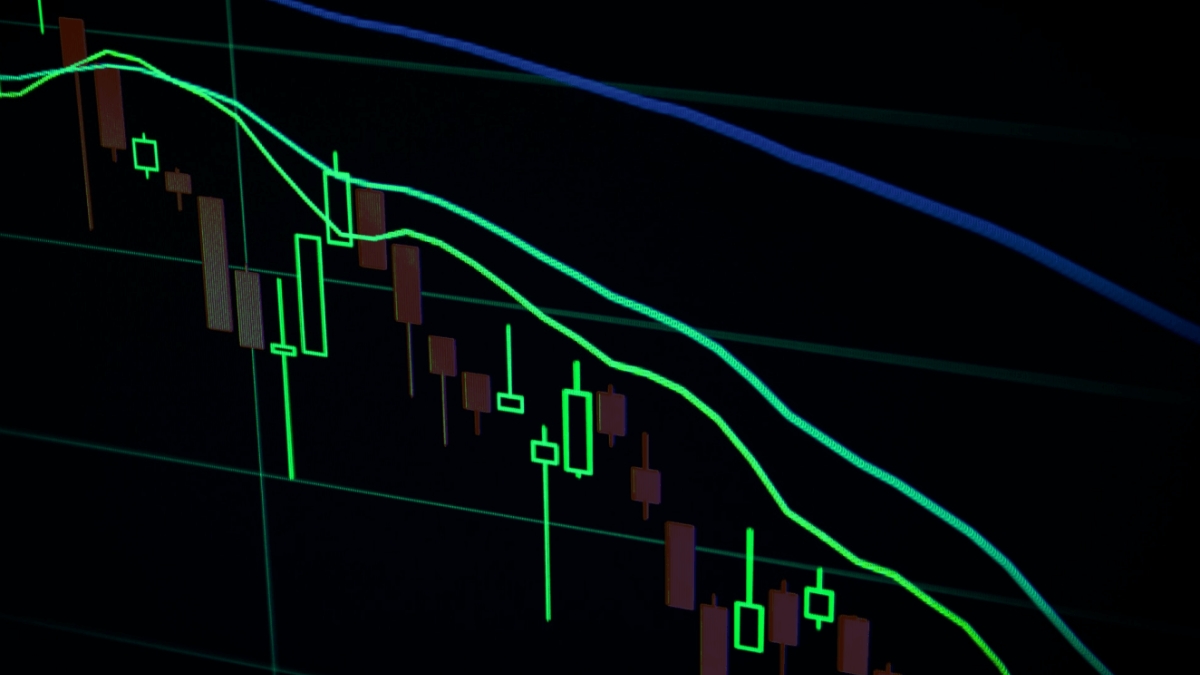-
 Bitcoin
Bitcoin $84,380.9629
-0.68% -
 Ethereum
Ethereum $1,587.8040
0.39% -
 Tether USDt
Tether USDt $0.9997
0.02% -
 XRP
XRP $2.0611
-0.10% -
 BNB
BNB $592.1695
0.41% -
 Solana
Solana $134.0171
-0.42% -
 USDC
USDC $1.0000
0.00% -
 Dogecoin
Dogecoin $0.1576
1.44% -
 TRON
TRON $0.2401
-3.06% -
 Cardano
Cardano $0.6295
2.16% -
 UNUS SED LEO
UNUS SED LEO $9.2244
1.69% -
 Chainlink
Chainlink $12.5592
0.40% -
 Avalanche
Avalanche $19.0618
0.03% -
 Toncoin
Toncoin $2.9920
1.85% -
 Stellar
Stellar $0.2398
0.17% -
 Shiba Inu
Shiba Inu $0.0...01228
4.28% -
 Hedera
Hedera $0.1653
1.46% -
 Sui
Sui $2.1201
-0.04% -
 Bitcoin Cash
Bitcoin Cash $335.2957
0.47% -
 Polkadot
Polkadot $3.6693
0.93% -
 Litecoin
Litecoin $75.9657
1.55% -
 Hyperliquid
Hyperliquid $17.0326
-0.70% -
 Dai
Dai $1.0000
0.01% -
 Bitget Token
Bitget Token $4.4071
0.71% -
 Ethena USDe
Ethena USDe $0.9992
0.02% -
 Pi
Pi $0.6423
4.69% -
 Monero
Monero $215.4419
-0.65% -
 Uniswap
Uniswap $5.1801
0.13% -
 Pepe
Pepe $0.0...07322
1.11% -
 OKB
OKB $50.2807
-0.70%
How much money is deducted from a perpetual contract every day
The funding rate for perpetual contracts, calculated as the annualized difference between the perp price and spot price, incentivizes traders to balance long and short positions, ensuring the perp price remains aligned with the spot price.
Nov 03, 2024 at 09:03 pm

Understanding Perpetual Contract Funding Rates
Perpetual contracts, commonly known as "perps," are financial instruments that allow traders to speculate on the future price of an underlying asset without an expiration date. As a result, perpetual contract positions can be held indefinitely.
To facilitate the seamless continuation of perp contracts, exchanges employ a funding rate mechanism, which is a small fee paid (or received) by traders based on the difference between the perp price and the spot price of the underlying asset. This fee ensures that the perp price remains closely aligned with the spot price.
How Funding Rates Work
Calculating the Funding Rate:
The funding rate is calculated as the annualized difference between the perp price (P) and the spot price (S), multiplied by the contract notional value (K) and a factor of 365 days.
Funding Rate = ((P - S) / S) K 365
Adjusting Positions:
Traders holding long perpetual contract positions (betting on a price increase) will pay the funding rate to traders holding short positions (betting on a price decrease). This process incentivizes traders to maintain an equilibrium between long and short positions and aligns the perp price with the spot price.
Settlement:
The funding rate is typically settled every eight hours (on OKX) or every six hours (on other exchanges). At these settlement intervals, traders holding long positions will transfer funds to traders holding short positions.
Impact of Funding Rates
- Convergence with Spot Price: Funding rates help maintain the perp price close to the spot price, preventing significant deviations.
- Traders' Behavior: High funding rates can influence traders' decisions by making it more expensive to hold long or short positions, thus encouraging market neutrality.
- Profitability: Traders can potentially profit from funding rate adjustments by strategically adjusting their positions based on the funding rate trajectory.
Example:
Let's say the perpetual contract price for ETH/USD is $1,200 and the spot price is $1,190. The notional value of each contract is $1,000.
The funding rate would be calculated as:
Funding Rate = ((1,200 - 1,190) / 1,190) 1,000 365 = 0.0033 USD
Therefore, traders holding long positions would pay 0.0033 USD to traders holding short positions for every $1,000 worth of ETH/USD perp contract every eight hours on OKX.
Disclaimer:info@kdj.com
The information provided is not trading advice. kdj.com does not assume any responsibility for any investments made based on the information provided in this article. Cryptocurrencies are highly volatile and it is highly recommended that you invest with caution after thorough research!
If you believe that the content used on this website infringes your copyright, please contact us immediately (info@kdj.com) and we will delete it promptly.
- BNB Buying Demand Rises as Market Sentiment Turns Positive
- 2025-04-19 08:20:16
- FUR PFP Campaign
- 2025-04-19 08:20:16
- The legal fight against crypto exchanges flares up again
- 2025-04-19 08:15:13
- Presidential Crypto Advisory Committee Head Bo Hines Highlights Ways the United States Could Improve Its Bitcoin (BTC) Reserves
- 2025-04-19 08:15:13
- Prominent Bitcoin Pundit Davinci Jeremic Has Shared a Bullish Outlook for XRP Despite His Long-Standing Reservations About the Ripple-Linked Coin
- 2025-04-19 08:10:15
- Broncos Give 2025 Reaches Nearly 1200 Donors
- 2025-04-19 08:10:15
Related knowledge

How does Tail Protection reduce the loss of liquidation?
Apr 11,2025 at 01:50am
Introduction to Tail Protection in CryptocurrencyTail Protection is a mechanism designed to mitigate the risks associated with liquidation in cryptocurrency trading. Liquidation occurs when a trader's position is forcibly closed by the exchange due to insufficient margin to cover potential losses. This often happens in leveraged trading, where traders b...

What are the consequences of an imbalance in the long-short ratio?
Apr 13,2025 at 02:50pm
The long-short ratio is a critical metric in the cryptocurrency trading world, reflecting the balance between bullish and bearish sentiments among traders. An imbalance in this ratio can have significant consequences on the market dynamics, affecting everything from price volatility to trading strategies. Understanding these consequences is essential fo...

How to judge the market trend by the position volume?
Apr 11,2025 at 02:29pm
Understanding how to judge the market trend by position volume is crucial for any cryptocurrency trader. Position volume, which refers to the total number of open positions in a particular cryptocurrency, can provide valuable insights into market sentiment and potential price movements. By analyzing this data, traders can make more informed decisions ab...

Why does a perpetual contract have no expiration date?
Apr 09,2025 at 08:43pm
Perpetual contracts, also known as perpetual futures or perpetual swaps, are a type of derivative product that has gained significant popularity in the cryptocurrency market. Unlike traditional futures contracts, which have a fixed expiration date, perpetual contracts do not expire. This unique feature raises the question: why does a perpetual contract ...

Why is the full-position mode riskier than the position-by-position mode?
Apr 13,2025 at 03:42pm
Why is the Full-Position Mode Riskier Than the Position-by-Position Mode? In the world of cryptocurrency trading, the choice between full-position mode and position-by-position mode can significantly impact the risk profile of a trader's portfolio. Understanding the differences between these two modes is crucial for making informed trading decisions. Th...

How is the liquidation price calculated?
Apr 12,2025 at 01:35am
Introduction to Liquidation PriceLiquidation price is a critical concept in the world of cryptocurrency trading, particularly when dealing with leveraged positions. Understanding how this price is calculated is essential for traders to manage their risk effectively. The liquidation price is the point at which a trader's position is forcibly closed by th...

How does Tail Protection reduce the loss of liquidation?
Apr 11,2025 at 01:50am
Introduction to Tail Protection in CryptocurrencyTail Protection is a mechanism designed to mitigate the risks associated with liquidation in cryptocurrency trading. Liquidation occurs when a trader's position is forcibly closed by the exchange due to insufficient margin to cover potential losses. This often happens in leveraged trading, where traders b...

What are the consequences of an imbalance in the long-short ratio?
Apr 13,2025 at 02:50pm
The long-short ratio is a critical metric in the cryptocurrency trading world, reflecting the balance between bullish and bearish sentiments among traders. An imbalance in this ratio can have significant consequences on the market dynamics, affecting everything from price volatility to trading strategies. Understanding these consequences is essential fo...

How to judge the market trend by the position volume?
Apr 11,2025 at 02:29pm
Understanding how to judge the market trend by position volume is crucial for any cryptocurrency trader. Position volume, which refers to the total number of open positions in a particular cryptocurrency, can provide valuable insights into market sentiment and potential price movements. By analyzing this data, traders can make more informed decisions ab...

Why does a perpetual contract have no expiration date?
Apr 09,2025 at 08:43pm
Perpetual contracts, also known as perpetual futures or perpetual swaps, are a type of derivative product that has gained significant popularity in the cryptocurrency market. Unlike traditional futures contracts, which have a fixed expiration date, perpetual contracts do not expire. This unique feature raises the question: why does a perpetual contract ...

Why is the full-position mode riskier than the position-by-position mode?
Apr 13,2025 at 03:42pm
Why is the Full-Position Mode Riskier Than the Position-by-Position Mode? In the world of cryptocurrency trading, the choice between full-position mode and position-by-position mode can significantly impact the risk profile of a trader's portfolio. Understanding the differences between these two modes is crucial for making informed trading decisions. Th...

How is the liquidation price calculated?
Apr 12,2025 at 01:35am
Introduction to Liquidation PriceLiquidation price is a critical concept in the world of cryptocurrency trading, particularly when dealing with leveraged positions. Understanding how this price is calculated is essential for traders to manage their risk effectively. The liquidation price is the point at which a trader's position is forcibly closed by th...
See all articles
























































































